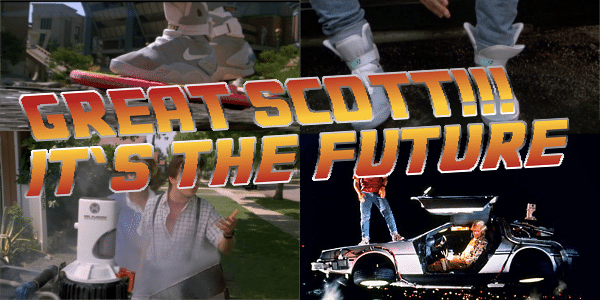Back in 1989, Back to the Future Part II came out in theaters. Unlike its retro predecessor, this movie looked ahead to the future, which arrived this past January 1st. (Yes, we now live in the future, in case smart phones and 3D printing weren’t heavy enough hints). So, looking back to 26 years ago, how did Back to the Future do at predicting what 2015 would look like? The particular year was an interesting choice. The writers had to have realized that most of the audience would live to see 2015, so they were predicting a future which they could and would be judged against. Now 2015 is here, and a reckoning is due.
So without further ado …
Back to the Present. What did Back to the Future II get right and wrong?
Wrong:
- Hover Cars – This is strictly a no. There are a few concepts for flying cars of the aerodynamic variety, but the hover technology portrayed in the movie is still strictly science fiction.
- Mr. Fusion – Good lord, no! House nuclear appliances are a bad idea, and fortunately no one seems to be on the verge of this one.
- Sleep Inducer – Doc knocks out Jennifer with this little gizmo, but medical science has stuck to anesthetic drugs. A pipe wrench can generate a similarly speedy loss of consciousness, but without the “don’t worry, she’ll be fine” aspect.
- Self-resizing clothes – Nope. Didn’t happen. If your clothes don’t fit, it’s live with it or get the help of a tailor.
- Holographic ads – We still lack the technology for free-floating holograms. And Jaws stopped at 4 movies, not 19.
- Video-screen waitstaff – While you can order online at many take-out places, you can’t walk into a restaurant and argue with a culinary-minded AI over your choice of meal.
- Food hydrator – I think this one might violate the conservation of mass. Older sci-fi seemed obsessed with food pills, rehydrating food, and other such nonsense. We’ve invented a million household gadgets since 1985 (or 1989, when II was released), but nothing has come along to revolutionize household cooking like the microwave did, and they had those in 1985.
Right:
- Weather forecasts to the second – I’m cutting the movie some slack. Weather is pretty accurate these days. Those who gripe about the day’s high being off or a storm going out to sea are either forgetting or are too young to remember 80’s weather reporting. It was dartboard stuff by today’s standards. And if you do want really accurate weather nowadays, you can often get up-to-the-minute satellite radar maps on your smartphone. You can see that a front will move over at 7:15PM and be clear of your area by 9:00. I’m calling this a hit for the writers.
- Rejuvenation Clinics – Doc comically removed his “disguise” only to look identical beneath it. But he claims modern medicine has added 40 years to his life. The 40-year claim might be stretching things a bit, but medical science can significantly prolong lives, and anti-aging treatments are out there. Most are cosmetic-only, but an honest breakthrough into reversing the harmful effects of aging promises not to be far off.
- Power shoelaces – In a case of life imitating art, Nike has actually made these. They’re supposed to be revealed this year.
- Bionic implants – While we’re not using them to empower mentally unstable hooligans like Griff Tannen, these do exist in various forms. Most are being used either experimentally or for people with missing limbs.
- Hoverboard – Yeah, I was a little surprised myself to be adding this one to the “right” list, but like the shoelaces, Back to the Future inspired someone to actually make it. The Hendo hoverboard may not be the street-roaming skateboard replacement sown in the movie, but it’s a damn sight better than some of the hoaxes. It uses magnetic repulsion, and seems to require a special surface to generate the opposing force, but otherwise this is pretty legit. If they can find a way someday to use the Earth’s magnetic field instead of a special floor, this could possibly look like the movie.
- Thumbprint ID – The McFly residence has a thumbprint lock to allow entry. While most houses don’t have this feature, they easily could. The iPhone 6 has this as a standard security feature. Home run.
- Voice activated house – Everything in the McFly house responds to voice commands. While this is far from standard, all the technology to do this exists today, and many homes are at least partially automated (timed lights, remote control via smartphone app, etc.). Aside from the rate of adoption by 2015 (the McFlys seem to be lower middle class), this is dead on. Our computerized voices are worlds better, too.
- Visor phone – Google glass.
- Home fax – This is probably the most notable overshoot. No one is getting faxes at home because the fax machine is a dead technology. Only archaic organizations still use them, and multi-function printers still support is because “why not?” It just uses the scanner and a phone line, and probably $0.05 worth of software licensing (if that isn’t freeware by now).
And while we’re at it, here are a list of brands shown/mentioned in Back to the Future II:
100% are still doing business today.
They also mention Miami losing a World Series to the Cubs. While an initial reaction might be that this was a miss, remember that the Florida Marlins play in Miami. Really, their mistake was having two NL teams in the World Series.


0 Comments